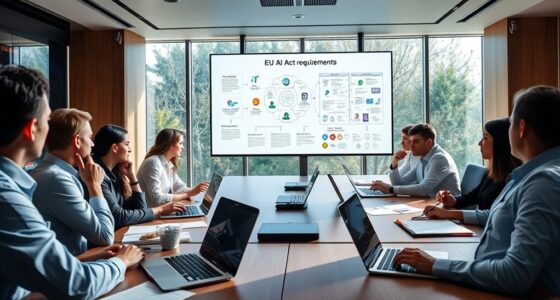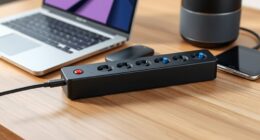SOC 2 Type I and Type II reports both evaluate a company’s controls related to security, but they differ in scope and duration. Type I focuses on the design and implementation of controls at a specific point in time, while Type II tests how well those controls operate over at least six months. If you want long-term assurance, Type II is the way to go. Keep exploring to discover which option fits your needs best.
Key Takeaways
- SOC 2 Type I assesses controls’ design and implementation at a specific point, while Type II evaluates their operational effectiveness over at least six months.
- Type I provides a snapshot of control structure; Type II offers ongoing assurance through extended testing.
- Type I is quicker and less costly, suitable for initial assessments; Type II supports continuous improvement and long-term trust.
- Type II includes testing of policies, procedures, and controls over time, ensuring they function consistently.
- Choosing between them depends on whether you need a quick control snapshot or comprehensive, ongoing validation.
What Is SOC 2 Certification?

SOC 2 certification is a widely recognized standard that evaluates how well a company manages and protects customer data. It focuses on key areas like cloud security and vendor management, ensuring that your organization has strong controls in place to safeguard sensitive information. Achieving SOC 2 means you’ve implemented processes to monitor security risks, manage third-party vendors effectively, and maintain data integrity. This certification reassures clients that your company takes data protection seriously and adheres to industry best practices. It involves a thorough audit of your controls, policies, and procedures related to security, availability, processing integrity, confidentiality, and privacy. By obtaining SOC 2, you demonstrate your commitment to maintaining a secure and trustworthy environment for your customers’ data. Additionally, understanding the types of SOC 2 reports can help organizations prepare for the specific scope and depth of the audit process.
Defining SOC 2 Type I and Type II
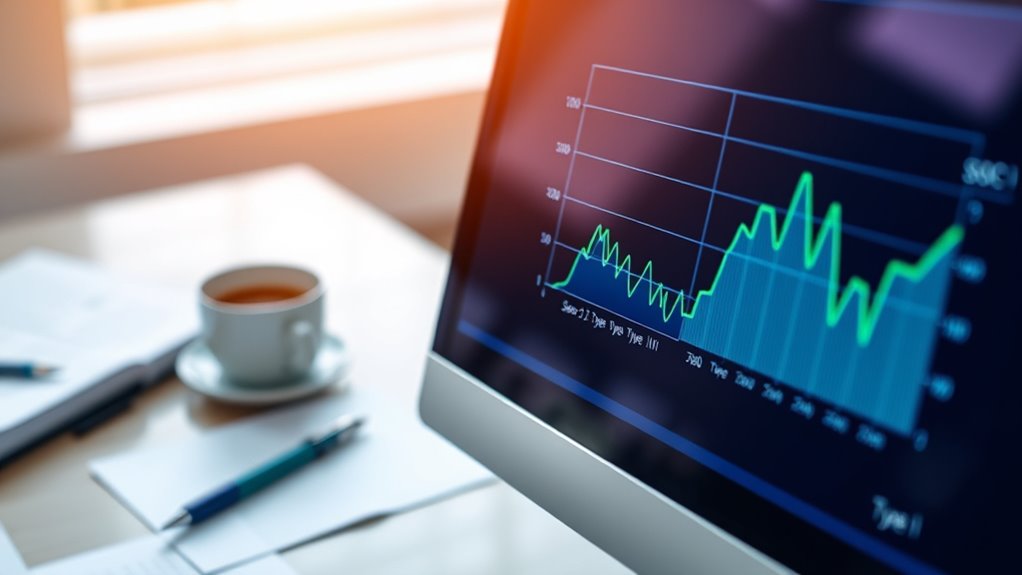
Understanding the differences between SOC 2 Type I and Type II starts with recognizing their audit focus areas and evaluation periods. Type I assessments review controls at a specific point in time, while Type II audits cover these controls over several months. This distinction helps you determine which report best meets your organization’s security and compliance needs. Additionally, understanding digital literacy is essential for organizations aiming to foster a secure digital environment.
Audit Focus Areas
How do the audit focus areas differ between SOC 2 Type I and Type II reports? In a Type I report, the focus is on evaluating the design of controls at a specific point in time, emphasizing areas like cloud security and vendor management. You’ll see an assessment of whether controls are suitably designed to meet trust service criteria. In contrast, Type II reports examine both the design and operational effectiveness of these controls over a period, typically six months. This means your audit digs deeper into how controls perform consistently, especially in critical areas like cloud security and vendor management. The key difference is the scope: Type I is a snapshot, while Type II offers a comprehensive view of ongoing control effectiveness.
Timeframe of Evaluation
The timeframe over which controls are evaluated distinguishes SOC 2 Type I from Type II reports. In a Type I report, your controls are appraised at a specific point in time, providing a snapshot of your compliance status. This allows for quick vendor assessment and helps demonstrate your controls’ design effectiveness during that moment. Conversely, a Type II report covers a period, typically six months or more, during which your controls are tested for operational effectiveness. This ongoing evaluation offers a thorough view, making it more valuable for compliance reporting and evaluating long-term reliability. By understanding these timeframes, you can better prepare your organization and choose the right report type based on your compliance goals and vendor assessment needs. Additionally, assessment scope plays a crucial role in determining how comprehensive your SOC 2 report will be.
Scope and Focus of SOC 2 Type I Reports

SOC 2 Type I reports focus on evaluating the design and implementation of a service organization’s controls at a specific point in time. Your primary goal is to demonstrate how well your controls are structured to meet trust service criteria. This involves a thorough vendor assessment, where auditors review your controls to ensure they’re properly organized. You’ll also use compliance benchmarking to compare your controls against industry standards. Keep in mind, the report doesn’t assess the operational effectiveness over time, only the control design at the moment of assessment. This makes it ideal for providing stakeholders with a snapshot of your controls’ robustness. Overall, the scope centers on control design, not ongoing performance, making it a concise, focused evaluation for your organization. Additionally, understanding potential risks associated with the controls can help you better prepare for future audits and compliance requirements.
Scope and Focus of SOC 2 Type II Reports
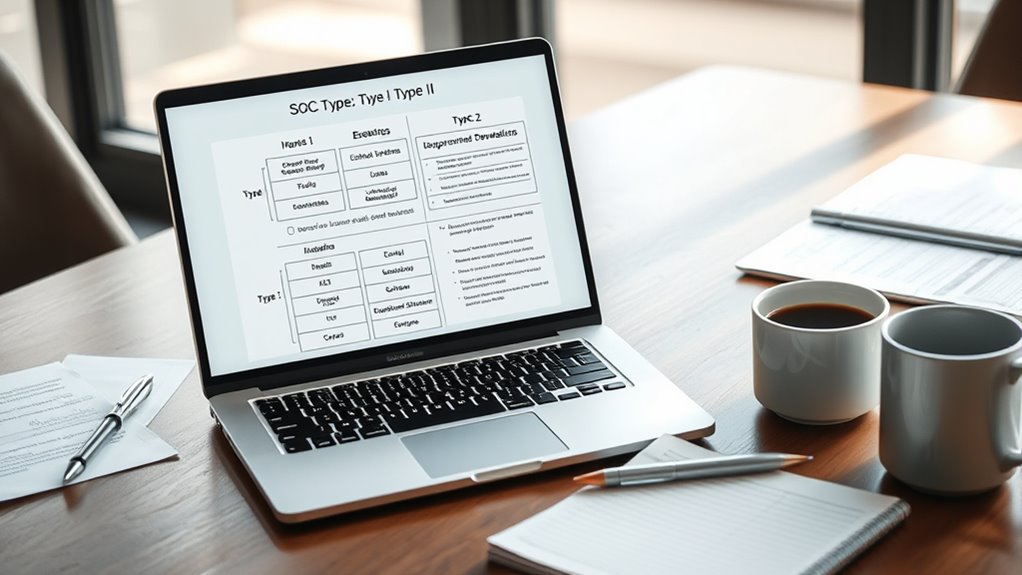
A SOC 2 Type II report involves a thorough evaluation of your controls over an extended period, typically six months or more. It emphasizes ongoing security assurance, meaning your controls are tested repeatedly to confirm their effectiveness. This broader scope provides a deeper understanding of your organization’s ability to maintain security over time. Additionally, the process often includes assessing organizational controls to ensure sustained compliance and operational integrity.
Comprehensive Controls Evaluation
Understanding the scope and focus of SOC 2 Type II reports is essential because these assessments provide a thorough evaluation of controls over an extended period. During this process, you’ll examine how well your controls support risk mitigation, especially in vendor assessments. A detailed controls evaluation covers policies, procedures, and operational effectiveness, giving you confidence in your security posture. By reviewing controls over several months, you identify gaps that could compromise data security or compliance. This evaluation helps ensure your vendor relationships don’t introduce unnecessary risks. Ultimately, a detailed SOC 2 Type II report demonstrates your commitment to maintaining effective controls, which strengthens trust with clients and partners while supporting ongoing risk management efforts. Additionally, understanding the vetted controls in place ensures your organization adheres to industry standards and best practices.
Ongoing Security Assurance
Ongoing security assurance focuses on maintaining and demonstrating the effectiveness of controls over time, ensuring that security measures remain robust amidst evolving threats. With SOC 2 Type II reports, you verify that controls related to cloud compliance and vendor risk management continue to function effectively beyond the initial assessment. This ongoing process helps identify gaps, adapt to new security challenges, and strengthen your security posture. Key aspects include:
- Regular testing of controls to confirm continued effectiveness
- Monitoring cloud compliance standards consistently
- Evaluating vendor risk management practices
- Addressing security incidents promptly
- Ensuring controls adapt to evolving threats
- Creativity can play a role in developing innovative solutions to security challenges, fostering resilience and adaptability in your security strategies.
This focus helps you build trust with clients and partners, showing your commitment to sustained security and compliance over the long term.
Extended Audit Period
Extended audit periods in SOC 2 Type II reports broaden the scope of assessment, covering controls over a longer timeframe—typically six months to a year. This extended audit timeline allows auditors to evaluate how well your controls operate consistently over the entire reporting period. Unlike Type I reports, which focus on controls at a specific point in time, Type II reports provide a more expansive view of your security posture. By examining controls throughout the entire reporting period, you can identify patterns, recurring issues, and improvements. This detailed scope offers clients and stakeholders greater confidence in your organization’s ongoing compliance and operational effectiveness. Ultimately, the extended audit period helps ensure your controls are not just effective on a snapshot date but throughout the entire duration of the assessment. Understanding compliance requirements is essential to maintaining trust in your organization’s security measures.
Duration and Testing Periods for Each Type

The duration and testing periods for SOC 2 Type I and Type II reports differ considerably, reflecting their distinct scopes. Type I assessments review controls at a specific point in time, often lasting a few days to weeks. In contrast, Type II evaluations span a minimum of six months, providing an extensive view of control effectiveness over time. This extended period enhances your ability to identify risks and refine compliance strategies. Essential oils, known for their therapeutic properties, are not directly related but exemplify the importance of ongoing, consistent application—much like the continuous monitoring in Type II assessments.
SOC 2 Type I offers a snapshot, while Type II provides an in-depth, six-month view of controls in action.
Consider these key points:
- Type I tests controls on a snapshot basis
- Type II covers ongoing control performance
- Longer periods support better risk mitigation
- Testing duration influences report depth
- Duration aligns with your organization’s compliance goals
Understanding these differences helps you plan audits effectively and strengthen your overall security posture.
When to Choose Type I Over Type II
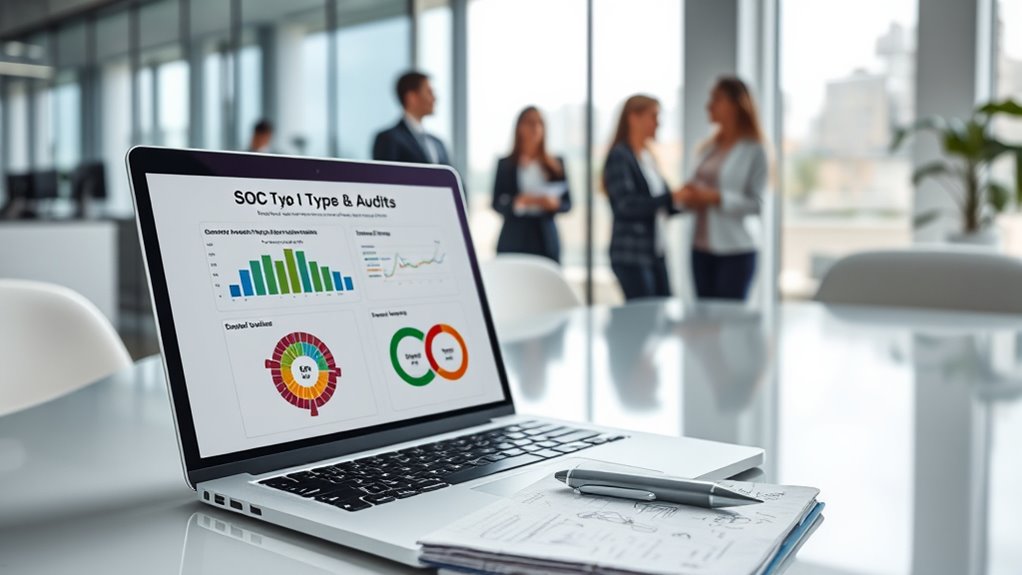
Choosing a SOC 2 Type I report is appropriate when your organization needs a quick assessment of controls at a specific point in time, such as during the initial stages of a compliance initiative or before a critical audit. If you’re focused on establishing baseline controls, it allows you to perform a swift risk assessment and gauge your compliance readiness without the extended testing period of a Type II report. Type I is ideal when you want to identify gaps early and demonstrate control design effectiveness to stakeholders or clients. It’s also useful if your organization is in a rapid growth phase or undergoing significant changes, where a snapshot of controls provides valuable insights without the need for ongoing testing.
Advantages and Limitations of Both Reports

Both SOC 2 Type I and Type II reports offer distinct advantages and limitations that can impact your decision-making process. They provide third-party validation of your controls, boosting stakeholder confidence. Type I reports are quicker and less expensive, making them ideal for initial assessments or when cost considerations are a priority. Type II reports, however, evaluate controls over an extended period, offering a more all-encompassing view of your security and operational effectiveness. Additionally, understanding the role of contrast ratio in assessing quality can inform how these reports reflect your organization’s control environment. Consider these points: – Type I offers faster, more affordable validation – Type II provides ongoing assurance through testing over time – Both reports enhance credibility with clients and partners – Type I may not capture control effectiveness – Cost considerations influence your choice based on needs
Choosing the right report depends on your organization’s goals and risk appetite.
How to Interpret and Use SOC 2 Reports Effectively

Wondering how to make the most of your SOC 2 report? Start by understanding the audit methodologies used, as they reveal the report’s depth and reliability. Use the report to evaluate your compliance strategies and identify gaps. Focus on key areas like control effectiveness and scope. To interpret the report effectively, consider this table:
| Aspect | What to Look For | Action Steps |
|---|---|---|
| Audit Methodologies | Testing procedures, scope | Assess if they match your needs |
| Control Effectiveness | Implementation and results | Adjust controls accordingly |
| Report Scope | Systems, processes covered | Ensure alignment with your goals |
Additionally, reviewing the content accuracy of the report can help ensure that the information aligns with your organization’s actual controls and practices.
Frequently Asked Questions
How Often Should a Company Update Its SOC 2 Report?
You should update your SOC 2 report based on your compliance renewal schedule, typically annually. The report update frequency depends on your organization’s risk environment and client requirements. Regular updates ensure ongoing compliance and demonstrate your commitment to security. Staying current with your report helps you address new vulnerabilities and maintain trust. Make sure to align your update schedule with your overall compliance plan for consistent and reliable security assurance.
Can SOC 2 Reports Be Combined With Other Compliance Certifications?
When it comes to compliance integration, you can definitely combine SOC 2 reports with other certifications to streamline your efforts. While there’s some certification overlap, it’s essential to verify each report covers the required controls thoroughly. Combining reports can save time and resources, but make sure your auditors coordinate well so you don’t get caught between a rock and a hard place. It’s a win-win if managed properly.
What Are Common Challenges in Achieving SOC 2 Compliance?
When working towards SOC 2 compliance, you often face challenges like effective risk management and employee training. You need to identify vulnerabilities and implement controls, which can be complex. Ensuring your team understands security protocols through thorough training is vital. Balancing these elements takes time and effort, but addressing them proactively helps you meet compliance standards and strengthens your overall security posture.
How Does SOC 2 Impact Client Trust and Business Growth?
Think of SOC 2 as a sturdy bridge that connects your business to client trust. When you achieve SOC 2 compliance, you boost client confidence and strengthen your brand reputation. This assurance shows clients you’re committed to security and reliability, making them more likely to choose you over competitors. As trust grows, so does your business’s potential for growth, creating a solid foundation for long-term success and loyal partnerships.
Are There Industry-Specific Considerations for SOC 2 Reporting?
You should consider industry-specific considerations for SOC 2 reporting because sector nuances and industry regulations shape your security controls. Different industries face unique threats and compliance standards, which means your SOC 2 report must address those particular risks. By tailoring your controls and audit scope to your sector, you demonstrate compliance and build trust with clients, showing you’re committed to meeting industry expectations and securing their data effectively.
Conclusion
So, now you’re armed with the scoop on SOC 2 types. Whether you pick the quick “flash” of Type I or the “marathon” of Type II, just remember: it’s all about convincing clients you’re secure—no matter how long the report takes. So go ahead, choose your adventure wisely. After all, in the world of cybersecurity, who doesn’t love a good report to keep the hackers guessing? Stay secure, or at least look like you are.



